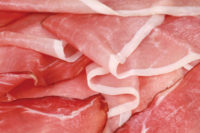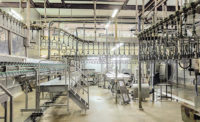Processing Tech
Improved sanitation and design on slicers, dicers and cutters
A cleaner cut: Improved sanitation and design is creating the slicers, dicers and cutters of the future.

Food production robots solve two problems: preventing worker injuries caused by machines or repetitive motions and improving consistency and speed in cuts. Now, wash-down robotic systems are also preventing food contamination. Improved sanitation and design on slicers, dicers and cutters in general continues to motivate the food industry.
Food contamination remains a stubborn problem to solve. According to the Centers for Disease Control and Prevention, about 48 million people in the United States still get food-borne illnesses — roughly one in six Americans.
Wash-down robots can provide a more streamlined cleaning process and even eliminate the need for humans. They have smooth casings, better ingress ratings and no loose wires for a thorough cleaning at the end of every work cycle — even by other wash-down robots.
“I have seen a lot more wash-down robotics systems in the past few years,” notes Gary McMurray, associate director at Collaborative Robotics, Georgia Tech Research Institute (GTRI), based in Atlanta.
These robots also usually come equipped with a protective surface that is resistant to bacteria, chemicals and an intense cleaning process or antiseptics and water pressure. They also must maintain an IP67 (wash down) rating for hygienic production lines because they deal with unwrapped food.
For companies that can’t rely on robotic help, the equipment manufacturer must take into account the cleanability of the equipment and the quality of the metal used, such as stainless steel 316 versus 304, says Warren Gilbert, a partner at FSS Corp., based in Elkhorn, Wis. In this case, he gives the nod to 316 as the superior stainless metal because of its ability to maintain an edge and last in a caustic environment.
“When using a better metal and pre-operational inspections, processors will find better efficiencies, cleaner cuts and a better quality product,” he says.
Under Global Food Safety Initiative (GFSI)-recognized audit platforms such as Safe Quality Food (SQF) or British Retail Consortium (BRC), there has to be a lot of validation of the cleaning process, Gilbert says.
“This includes equipment and environmental swabbing, blade or knife inspection programs, etc.,” he says.
To improve sanitary design and hygienic longevity of the equipment in challenging environments, some interesting slicer innovations include the implementation of solid materials in frames and other support elements within the equipment.
“It’s also important to note that the adoption and evolution of sanitary design standards are driving improvements in the simplification of designs, which in turn reduces harborages and increases the accessibility and cleanability of equipment for our operators and janitors,” says Mike Bartikoski, senior vice president of operations at Land O’Frost, based in Munster, Ind.
The best-in-class equipment design can also do more with less.
“Whether it be blade design, sensors or communication cables, the equipment must be able to withstand the rigors of being taken apart daily, cleaned and sanitized,” says Mike Bliss, vice president of operations at Butterball, based in Garner, N.C.
Rethinking robotics
Robot butchers have found more success in the poultry industry — such as with high-volume chicken leg deboning — than the more variable beef industry. But robot manipulators and various vision sensors are being introduced in beef to eliminate dangerous cuts, such as rib cutting.
In 2012, GTRI created a prototype system that uses advanced imaging technology and a robotic cutting arm to automatically debone chicken and other poultry products. Now the lab is looking at rethinking the entire deboning process.
“We are starting a new project at GTRI looking at a new process for deboning a bird,” says McMurray. “The idea is, how could you integrate all of the cutting tasks into a single robotic work cell?”
This new project could lead to potential savings, as far as reducing floor space, the number of employees needed and other factors, McMurray says.
“The idea is not to simply drop in a robot where a person is, but look at reorganizing the process to take advantage of automation,” he says.
Improvements in automation are also leading to progress in labor efficiencies.
“Additionally, there has been notable progress made in the automation of handling and loading technologies to interface with a wider array of consumer-driven packaging solutions — such as multi-compartment trays and deli packs,” Bartikoski says. “The development of robotics and conveyor solutions to reduce labor in product loading continue to drive labor efficiencies.”
Optimizing blade maintenance
Blade and slicer technologies continue to advance, as well.
“Some of these include the ability to track individual blades and monitor their sharpening and maintenance,” Bartikoski says. “This helps ensure optimized blade life and product/machine compatibility.”
Thanks to improvements in both original blade manufacturing technologies and maintenance/sharpening capabilities, blade enhancements are ongoing.
“Finally, the evolution and advancements of weight control systems and interfaces within the slicing process continue to support improvements in the efficacy of weight control,” Bartikoski says.
Most slicer original equipment manufacturers (OEMs) continue to refine their equipment and processes to reduce heels at slicing — minimizing rework — and increasing first pass throughput, Bartikoski says.
In the end, the key to sustainable performance is the upkeep of the equipment. “Today’s slicers are designed with the user in mind, providing systems that enhance the ability to quickly troubleshoot and diagnose an issue and return the process to normal operation,” Bliss says.
Despite increases in automation, there’s still a need for trained operators.
“This, I believe, is the point of difference,” Bliss says. “We see today that most manufacturers are focusing on service after the sale. This again is a point of differentiation.” NP
Looking for a reprint of this article?
From high-res PDFs to custom plaques, order your copy today!









